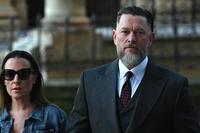On Dec. 5, 2012, Dr. Dilip Joseph, an aid worker who was training health-care providers in villages around Kabul, was returning to base when his car was stopped by a man with an AK-47. Joseph and two of his Afghan colleagues were quickly surrounded. He was suddenly a prisoner of the Taliban.
Three days later, he was rescued by a team of U.S. Navy SEALs, including Chief Special Warfare Operator (SEAL) Edward C. Byers Jr. Byers had been a SEAL for eight years in 2012, with multiple combat deployments -- and he would need that experience for this mission.
Joseph, his interpreter and driver were taken to a one-room building on a compound in Afghanistan's Laghman Province. Intelligence reports indicated that he would be moved and possibly killed the following day, so the Americans needed to rescue him as soon as possible.
Byers and his fellow SEALs had to hike through the Afghan wilderness for five hours before reaching the target building to make the rescue.
"Our target building where we thought the doctor was being held was in a compound that overlooked the entire valley," Byers said in a 2022 interview. "There was no way to walk up the valley to the compound because despite it being at night and even with low loom, once your eyes adjust, you can see across the valley, plain as day."
The team fanned out and assumed their areas of responsibility. Byers was on Echo Team, the one-room building where Joseph was held. Once in the area, they were spotted by a Taliban sentry who raised the alarm and ducked inside. The SEALs of Echo Team sprinted for the door.
"One of the Taliban guards had come out of the building with his rifle and [Petty Officer 1st Class] Nick Checque immediately engaged him," Byers recalled. "That was the catalyst of us rapidly accelerating our prosecution of the target."

The two spread out as they moved closer. When they got to the door, they realized the door was actually layers of wool blankets cemented into the doorframe on multiple sides. It was a situation, a breach, they'd never encountered before. Their full body weight couldn't free them from the frame. The SEALs would have to push through the blankets fully exposed to the enemy.
Checque ran ahead through the blankets, with Byers following behind. Upon entering the room, Byers saw an enemy figure in his night vision. With just seconds to react, he killed the Taliban fighter.
"I saw someone that was about 20 feet away from me, starting to present a weapon towards me," Byers said. "I was able to engage him, and make some very clean shots in his head, and dropped him."
The next thing he noticed was another figure scrambling across the floor to find a rifle in a dark corner. Unsure of where the hostage was, Byers moved in on the man, pinning him on the ground with his knees. They called out to Joseph, hoping to pinpoint which figure was their hostage and which were the enemy. Finally, Joseph called out to the Americans in English.
"We finally hear this voice, 'I'm over here; I'm over here,'" Byers said. "And it was not the person I'm on top of. I made the decision to shoot the person I'm on top of, and whether it killed him or subdued him, I was able to jump off of that person and I leapt across the room."
Byers leapt across the room to where the voice originated as shots filled the room. He threw himself on the doctor to shield him from the close-quarters shooting. As he protected Joseph, Byers engaged in a hand-to-hand struggle with a Taliban fighter, restraining the enemy until another SEAL shot him.
"The Taliban was within arms reach of me," recalled Byers. "I was able to hold Dr. Joseph against me with body armor, and I was able to reach over and pin that person against the wall by their throat. That had given the rest of the team enough time to make it inside and eliminate that threat."
The hostages were saved, but Checque was mortally wounded in his rush through the woolen door. As the team flew back to Bagram Air Base near the Afghan capital of Kabul, they tried to revive him but were unsuccessful. Checque was posthumously awarded the Navy Cross.
Two years after the daring rescue, Chairman of the Joint Chiefs of Staff Gen. Martin Dempsey recommended Byers for the Medal of Honor. It was presented to him at the White House by President Barack Obama on Feb. 29, 2016.

Byers said that in the time it took for him to describe the rescue is about the time it took for SEALs to enter the room, eliminate the five Taliban, determine that the hostage was able to be moved and then move him outside. Watch the entire interview and description of Byers' Medal of Honor action below:
-- Blake Stilwell can be reached at blake.stilwell@military.com. He can also be found on Twitter @blakestilwell or on Facebook.
Want to Learn More About Military Life?
Whether you're thinking of joining the military, looking for post-military careers or keeping up with military life and benefits, Military.com has you covered. Subscribe to Military.com to have military news, updates and resources delivered directly to your inbox.
















